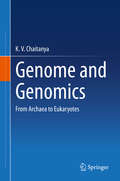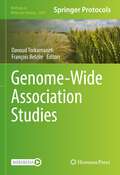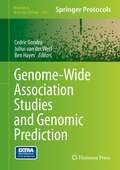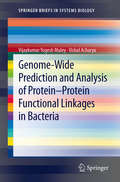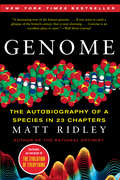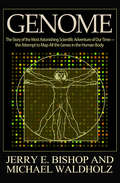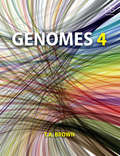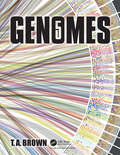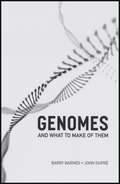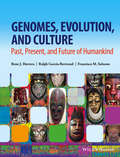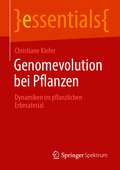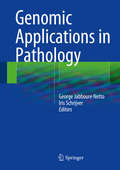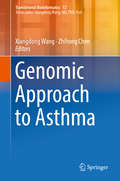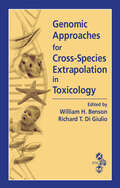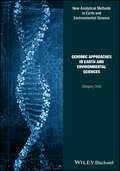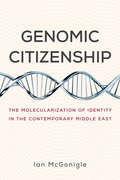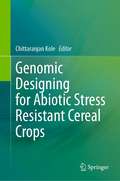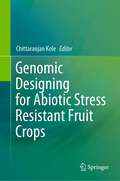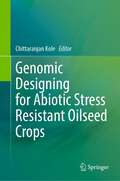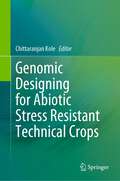- Table View
- List View
Genome and Genomics: From Archaea to Eukaryotes
by K. V. ChaitanyaThis book provides a detailed and up-to-dated information on the genomes belonging to three major life forms on Earth – archaea, prokaryotes and eukaryotes. Each section describes about the genome of a specific group of organisms, such as viruses, archaea, bacteria, eukaryotes and organellar genomes. Individual chapters provide details of their organization, structure, evolution, sequencing strategies and functions. Further, this book discusses the technologies that are applied for genome sequencing; assembly, annotation and gene prediction. Other topics include the genomes of important model organisms, mitochondria genome of Neanderthal fossil, etc. This book also examines the evolution of chloroplast and mitochondria genomes by comparing with bacteria, addresses the diseases that occur in humans due to the mutations in mitochondrial genome, gene therapy and engineering of chloroplast and mitochondrial genomes. Lastly, it features an overview of the role of proteomics, exposomics, connectomics, metabolomics, and microbiomics. This book is a fascinating read for students, lecturers and researchers in the field of genetics, genomics, microbiology and life sciences.
Genome-Scale Algorithm Design: Biological Sequence Analysis in the Era of High-Throughput Sequencing
by Veli Mäkinen Djamal Belazzougui Fabio Cunial Alexandru I. TomescuHigh-throughput sequencing has revolutionised the field of biological sequence analysis. Its application has enabled researchers to address important biological questions, often for the first time. This book provides an integrated presentation of the fundamental algorithms and data structures that power modern sequence analysis workflows. The topics covered range from the foundations of biological sequence analysis (alignments and hidden Markov models), to classical index structures (k-mer indexes, suffix arrays and suffix trees), Burrows-Wheeler indexes, graph algorithms and a number of advanced omics applications. The chapters feature numerous examples, algorithm visualisations, exercises and problems, each chosen to reflect the steps of large-scale sequencing projects, including read alignment, variant calling, haplotyping, fragment assembly, alignment-free genome comparison, transcript prediction and analysis of metagenomic samples. Each biological problem is accompanied by precise formulations, providing graduate students and researchers in bioinformatics and computer science with a powerful toolkit for the emerging applications of high-throughput sequencing.
Genome-Wide Association Studies
by Krishnarao Appasani Scherer, Stephen W. and Appasani, Krishnarao Visscher, Peter M. Stephen W. Scherer Peter M. VisscherOver the last twenty years, genome-wide association studies (GWAS) have revealed a great deal about the genetic basis of a wide range of complex diseases and they will undoubtedly continue to have a broad impact as we move to an era of personalised medicine. This authoritative text, written by leaders and innovators from both academia and industry, covers the basic science as well as the clinical, biotechnological and pharmaceutical potential of these methods. With special emphasis given to highlighting pharmacogenomics and population genomics studies using next-generation technology approaches, this is the first book devoted to combining association studies with single nucleotide polymorphisms, copy number variants, haplotypes and expressed quantitative trait loci. A reliable guide for newcomers to the field as well as for experienced scientists, this is a unique resource for anyone interested in how the revolutionary power of genomics can be applied to solve problems in complex disease.
Genome-Wide Association Studies (Methods in Molecular Biology #2481)
by Davoud Torkamaneh François BelzileThis detailed collection explores genome-wide association studies (GWAS), which have revolutionized the investigation of complex traits over the past decade and have unveiled numerous useful genotype–phenotype associations in plants. The book describes the key concepts and methods underlying GWAS, including the genetic architecture underlying variation for phenotypic traits, the structure of genetic variation in plants, technologies for capturing genetic information, study designs, and the statistical models and bioinformatics tools used for data analysis. Written for the highly successful Methods in Molecular Biology series, chapters include the kind of invaluable implementation advice that leads to the most fruitful research results. Authoritative and practical, Genome-Wide Association Studies serves as an extremely valuable resource for the plant research community by rendering GWAS analysis less challenging and more accessible to a broader group of users.
Genome-Wide Association Studies and Genomic Prediction
by Ben Hayes Cedric Gondro Julius van der WerfWith the detailed genomic information that is now becoming available, we have a plethora of data that allows researchers to address questions in a variety of areas. Genome-wide association studies (GWAS) have become a vital approach to identify candidate regions associated with complex diseases in human medicine, production traits in agriculture, and variation in wild populations. Genomic prediction goes a step further, attempting to predict phenotypic variation in these traits from genomic information. Genome-Wide Association Studies and Genomic Prediction pulls together expert contributions to address this important area of study. The volume begins with a section covering the phenotypes of interest as well as design issues for GWAS, then moves on to discuss efficient computational methods to store and handle large datasets, quality control measures, phasing, haplotype inference, and imputation. Later chapters deal with statistical approaches to data analysis where the experimental objective is either to confirm the biology by identifying genomic regions associated to a trait or to use the data to make genomic predictions about a future phenotypic outcome (e.g. predict onset of disease). As part of the Methods in Molecular Biology series, chapters provide helpful, real-world implementation advice.
Genome-Wide Prediction and Analysis of Protein-Protein Functional Linkages in Bacteria
by Vishal Acharya Vijaykumar Yogesh MuleyUsing genome sequencing, one can predict possible interactions among proteins. There are very few titles that focus on protein-protein interaction predictions in bacteria. The authors will describe these methods and further highlight its use to predict various biological pathways and complexity of the cellular response to various environmental conditions. Topics include analysis of complex genome-scale protein-protein interaction networks, effects of reference genome selection on prediction accuracy, and genome sequence templates to predict protein function.
Genome: The Autobiography of a Species in 23 Chapters (P. S. Series)
by Matt RidleyThe genome's been mapped.<P> But what does it mean?<P> Arguably the most significant scientific discovery of the new century, the mapping of the twenty-three pairs of chromosomes that make up the human genome raises almost as many questions as it answers. Questions that will profoundly impact the way we think about disease, about longevity, and about free will. Questions that will affect the rest of your life.<P> Genome offers extraordinary insight into the ramifications of this incredible breakthrough. By picking one newly discovered gene from each pair of chromosomes and telling its story, Matt Ridley recounts the history of our species and its ancestors from the dawn of life to the brink of future medicine. From Huntington's disease to cancer, from the applications of gene therapy to the horrors of eugenics, Matt Ridley probes the scientific, philosophical, and moral issues arising as a result of the mapping of the genome. It will help you understand what this scientific milestone means for you, for your children, and for humankind.<P> Chosen for Mark Zuckerberg's "A Year of Books"
Genome: The Story of the Most Astonishing Scientific Adventure of Our Time - The Attempt to Map All the Genes in the Human Body
by Jerry E. Bishop Michael WaldholzBy far the best popular work written about the impact of molecular biology on science. An incisive, thoughtful and thorough work that educates and entertains.
Genome: The Story of the Most Astonishing Scientific Adventure of Our Time—the Attempt to Map All the Genes in the Human Body (Saber Mas Ser.)
by Jerry E. Bishop Michael WaldholzAn &“invaluable [and] highly readable&” account of the quest to map our DNA, the blueprint for life—and what it means for our future ( The Philadelphia Inquirer).Genome tells the story of the most ambitious scientific adventure of our time. By gradually isolating and identifying all the genes in the human body—the blueprint for life—scientists are closing in on the ability to effectively treat and prevent nearly every disease that strikes man, from muscular dystrophy, diabetes, and cancer to heart ailments, alcoholism, and even mental illness. Such discoveries will change the course of human life. At the same time, they raise profound ethical questions that have tremendous implications: Can insurance companies demand genetic tests to determine who poses a health risk? Should parents be able to choose their baby&’s sex or eye color? Will employers screen out potential employees who are genetically susceptible to occupational health problems? An exciting true tale of discovery that is revolutionizing our world, Genome helps us understand our future.
Genomes 4
by T. A. BrownGenomes 4 has been completely revised and updated. It is a thoroughly modern textbook about genomes and how they are investigated. As with Genomes 3, techniques come first, then genome anatomies, followed by genome function, and finally genome evolution. The genomes of all types of organism are covered: viruses, bacteria, fungi, plants, and animals including humans and other hominids. Genome sequencing and assembly methods have been thoroughly revised including a survey of four genome projects: human, Neanderthal, giant panda, and barley. Coverage of genome annotation emphasizes genome-wide RNA mapping, with CRISPR-Cas 9 and GWAS methods of determining gene function covered. The knowledge gained from these techniques forms the basis of the three chapters that describe the three main types of genomes: eukaryotic, prokaryotic (including eukaryotic organelles), and viral (including mobile genetic elements). Coverage of genome expression and replication is truly genomic, concentrating on the genome-wide implications of DNA packaging, epigenome modifications, DNA-binding proteins, non-coding RNAs, regulatory genome sequences, and protein-protein interactions. Also included are applications of transcriptome analysis, metabolomics, and systems biology. The final chapter is on genome evolution, focusing on the evolution of the epigenome, using genomics to study human evolution, and using population genomics to advance plant breeding. Established methods of molecular biology are included if they are still relevant today and there is always an explanation as to why the method is still important. Each chapter has a set of short-answer questions, in-depth problems, and annotated further reading. There is also an extensive glossary. Genomes 4 is the ideal text for upper level courses focused on genomes and genomics.
Genomes 5
by Terry A. BrownGenomes 5 has been completely revised and updated. It is a thoroughly modern textbook about genomes and how they are investigated. As with previous Genomes editions, techniques come first, then genome anatomies, followed by genome function, and finally genome evolution. The genomes of all types of organism are covered: viruses, bacteria, fungi, plants, and animals, including humans and other hominids. Genome sequencing and assembly methods have been thoroughly revised to include new developments in long-read DNA sequencing. Coverage of genome annotation emphasizes genome-wide RNA mapping, with CRISPR-Cas 9 and GWAS methods of determining gene function covered. The knowledge gained from these techniques forms the basis of the chapters that describe the three main types of genomes: eukaryotic, prokaryotic (including eukaryotic organelles), and viral (including mobile genetic elements). Coverage of genome expression and replication is truly genomic, concentrating on the genome-wide implications of DNA packaging, epigenome modifications, DNA-binding proteins, non-coding RNAs, regulatory genome sequences, and protein-protein interactions. Also included are examples of the applications of metabolomics and systems biology. The final chapter is on genome evolutionn, including the evolution of the epigenome, using genomics to study human evolution, and using population genomics to advance plant breeding. Established methods of molecular biology are included if they are still relevant today and there is always an explanation as to why the method is still important. Genomes 5 is the ideal text for upper-level courses focused on genomes and genomics. Key Features A highly accessible and well-structured book with chapters organized into four parts to aid navigation Superb artwork illustrates the key concepts and mechanisms Each chapter has a set of short-answer questions and in-depth problems to test the reader’s understanding of the material Thoroughly up to date with references to the latest research from the 2020s
Genomes and What to Make of Them
by Barry Barnes John Dupré"Genomes and What to Make of Them" opens with a brief history of the science of genetics and genomics, from Mendel to Watson and Crick and all the way up to Craig Venter. From there the authors delve into the use of genomics in determining evolutionary paths -- and what it can tell us, for example, about how far we really have come from our ape ancestors. Barnes and Dupré then consider both the power and risks of genetics, from the economic potential of plant genomes to overblown claims that certain human genes can be directly tied to such traits as intelligence or homosexuality. Ultimately, the authors argue, we are now living with a new knowledge as powerful in its way as nuclear physics, and the stark choices that face us -- between biological warfare and gene therapy, a new eugenics or a new agricultural revolution -- will demand the full engagement of both scientists and citizens.
Genomes, Evolution, and Culture
by Francisco M. Salzano Ralph Garcia-Bertrand Rene J. HerreraThis book combines recent information and discoveries in the field of human molecular biology and human molecular evolution. It provides an interdisciplinary approach drawing together data from various diverse disciplines to address both the more classical anthropological content and the current more contemporary molecular focus of courses. Chapters include a history of human evolutionary genetics; the human genome structure and function; population structure and variability; gene and genomic dynamics; culture; health and disease; bioethics; future.
Genomevolution bei Pflanzen: Dynamiken im pflanzlichen Erbmaterial (essentials)
by Christiane KieferDie Zellen eines jeden Lebewesens enthalten die Erbinformation in Form von DNA, auch Genom genannt, welche zu einem Großteil Aussehen und Funktion eines Organismus bestimmt. Auch bei Pflanzen ist das nicht anders. Die Erbinformation ist nicht statisch, sondern verändert sich mit großer Dynamik. In diesem essential erhalten Sie einen breiten Überblick über die Prozesse, welche das Pflanzengenom im Laufe der Evolution verändern. Was ist Polyploidie und warum kann sie die Entstehung von Genen mit neuen Funktionen fördern? Warum sind manche Pflanzengenome riesig und andere dagegen winzig, obwohl sie nahezu gleich viele Gene enthalten? Und welche Einblicke gewährt uns das Zeitalter genomischer Studien in die Veränderlichkeit und Flexibilität der Erbsubstanz?
Genomic Applications in Pathology
by Iris Schrijver George Jabboure NettoGenomic Applications in Pathology provides a state-of-the art review of the scientific principles underlying next generation genomic technologies and the required bioinformatics approaches to analyses of the daunting amount of data generated by current and emerging genomic technologies. Implementation roadmaps for various clinical assays such as single gene, gene panels, whole exome and whole genome assays are discussed together with issues related to reporting, including the pathologist's role in interpretation and clinical integration of genomic tests results. Genomic applications for site-specific solid tumors and hematologic neoplasms are detailed, as well as genomic applications in pharmacogenomics, inherited genetic diseases, and infectious diseases. The latest iteration of practice recommendations and guidelines in genomic testing, put forth by stakeholder professional organizations such as the Association for Molecular Pathology and the College of American Pathologists, are also discussed in the volume, as well as regulatory issues and laboratory accreditation related to genomic testing. Written by experts in the field, Genomic Applications in Pathology provides a comprehensive resource that is of great value to practicing molecular pathologists, hematopathologists, other subspecialized pathologists, general pathologists, pathology trainees, oncologists, and geneticists.
Genomic Approach to Asthma (Translational Bioinformatics #12)
by Xiangdong Wang Zhihong ChenThis volume in the series, Translational Bioinformatics, provides an up-to-date overview of genomic approaches to asthma. By applying unbiased “-omics” combined with disease-focused and hypothesis-driven approaches, it enhances readers’ understanding of the asthma endotype. Furthermore, it elucidates how progress in -omics research, such as “genomic,” “transcriptomic,” “protomic,” and “metabolomic,” is applied in asthma, and reports on the related series of important breakthroughs in asthma development, classification, prevention and drug sensitivity. Also covering systems biology knowledge and methodologies, computational models and biostatistical methods to analyze big data, this book provides a valuable resource for scientists and researchers in the field of asthma and respiratory diseases.
Genomic Approaches for Cross-Species Extrapolation in Toxicology
by William H. Benson Richard T. Di GiulioThe latest tools for investigating stress response in organisms, genomic technologies provide great insight into how different organisms respond to environmental conditions. However, their usefulness needs to be tested, verified, and codified. Genomic Approaches for Cross-Species Extrapolation in Toxicology provides a balanced discussion drawn from
Genomic Approaches in Earth and Environmental Sciences (Analytical Methods in Earth and Environmental Science)
by Gregory DickThe first comprehensive synthesis of genomic techniques in earth sciences The past 15 years have witnessed an explosion of DNA sequencing technologies that provide unprecedented insights into biology. Although this technological revolution has been driven by the biomedical sciences, it also offers extraordinary opportunities in the earth and environmental sciences. In particular, the application of "omics" methods (genomics, transcriptomics, proteomics) directly to environmental samples offers exciting new vistas of complex microbial communities and their roles in environmental and geochemical processes. This unique book fills the gap where there exists a lack of resources and infrastructure to educate and train geoscientists about the opportunities, approaches, and analytical methods available in the application of omic technologies to problems in the geosciences. Genomic Approaches in Earth and Environmental Sciences begins by covering the role of microorganisms in earth and environmental processes. It then goes on to discuss how omics approaches provide new windows into geobiological processes. It delves into the DNA sequencing revolution and the impact that genomics has made on the geosciences. The book then discusses the methods used in the field, beginning with an overview of current technologies. After that it offers in-depth coverage of single cell genomics, metagenomics, metatranscriptomics, metaproteomics, and functional approaches, before finishing up with an outlook on the future of the field. The very first synthesis of an important new family of techniques Shows strengths and limitations (both practical and theoretical) of the techniques Deals with both theoretical and laboratory basics Shows use of techniques in a variety of applications, including various aspects of environmental science, geobiology, and evolution Genomic Approaches in Earth and Environmental Sciences is a welcome addition to the library of all earth and environmental scientists and students working within a wide range of subdisciplines.
Genomic Citizenship: The Molecularization of Identity in the Contemporary Middle East
by Ian McGonigleAn anthropological study based on ethnographic work in Israel and Qatar explores the relationship between science, particularly genetics, and national identity.Based on ethnographic work in Israel and Qatar, two small Middle Eastern ethnonations with significant biomedical resources, Genomic Citizenship explores the relationship between science and identity. Ian McGonigle, originally trained as a biochemist, draws on anthropological theory, STS, intellectual history, critical theory, Middle Eastern studies, cultural studies, and critical legal studies. He connects biomedical research on ethnic populations to the political, economic, legal, and historical context of the state; to global trends in genetic medicine; and to the politics of identity in the context of global biomedical research. Genomic Citizenship is more an anthropology of scientific objects than an anthropology of scientists or an ethnography of the laboratory. McGonigle bases his untraditional project on traditional anthropological methods, including participant observation. Some of the most persuasive data in the book are from public records, legal and historical sources, published scientific papers, institutional reports, websites, and brochures. McGonigle discusses biological understandings of Jewishness, especially in relation to the intellectual history of Zionism and Jewish political thought, and considers the possibility of a novel application of genetics in assigning Israeli citizenship. He also describes developments in genetic medicine in Qatar and analyzes the Qatari Biobank in the context of Qatari nationalism and state-building projects. Considering possible consequences of findings on the diverse origins of the Qatari population for tribal identities, he argues that the nation cannot be defined as either a purely natural or biological entity. Rather, it is reified, reinscribed, and refracted through genomic research and discourse.
Genomic Clinical Trials and Predictive Medicine
by Richard M. SimonGenomics is majorly impacting therapeutics development in medicine. This book contains up-to-date information on the use of genomics in the design and analysis of therapeutic clinical trials with a focus on novel approaches that provide a reliable basis for identifying which patients are most likely to benefit from each treatment. It is oriented to both clinical investigators and statisticians. For clinical investigators, it includes background information on clinical trial design and statistical analysis. For statisticians and others who want to go deeper, it covers state-of-the-art adaptive designs and the development and validation of probabilistic classifiers. The author describes the development and validation of prognostic and predictive biomarkers and their integration into clinical trials that establish their clinical utility for informing treatment decisions for future patients.
Genomic Designing for Abiotic Stress Resistant Cereal Crops
by Chittaranjan KoleThis book presents abiotic stresses that cause crop damage in the range of 6-20%. Understanding the interaction of crop plants to the abiotic stresses caused by heat, cold, drought, flooding, submergence, salinity, acidity, etc., is important to develop resistant crop varieties. Knowledge on the advanced genetic and genomic crop improvement strategies including molecular breeding, transgenics, genomic-assisted breeding, and the recently emerging genome editing for developing resistant varieties in cereal crops is imperative for addressing FPNEE (food, health, nutrition, energy, and environment) security. Whole genome sequencing of these crops followed by genotyping-by-sequencing has facilitated precise information about the genes conferring resistance useful for gene discovery, allele mining, and shuttle breeding which in turn opened up the scope for 'designing' crop genomes with resistance to abiotic stresses. The nine chapters each dedicated to a cereal crop in this volume are deliberate on different types of abiotic stresses and their effects on and interaction with crop plants; enumerate on the available genetic diversity with regard to abiotic stress resistance among available cultivars; illuminate on the potential gene pools for utilization in interspecific gene transfer; are brief on the classical genetics of stress resistance and traditional breeding for transferring them to their cultivated counterparts; elucidate on the success stories of genetic engineering for developing abiotic stress-resistant crop varieties; discuss on molecular mapping of genes and QTLs underlying stress resistance and their marker-assisted introgression into elite varieties; enunciate on different emerging genomics-aided techniques including genomic selection, allele mining, gene discovery, and gene pyramiding for developing adaptive crop varieties with higher quantity and quality, and also elaborate some case studies on genome editing focusing on specific genes for generating abiotic stress-resistant crops.
Genomic Designing for Abiotic Stress Resistant Fruit Crops
by Chittaranjan KoleThis book presents deliberations on molecular and genomic mechanisms underlying the interactions of crop plants to the abiotic stresses caused by heat, cold, drought, flooding, submergence, salinity, acidity, etc., important to develop resistant crop varieties. Knowledge on the advanced genetic and genomic crop improvement strategies including molecular breeding, transgenics, genomic-assisted breeding, and the recently emerging genome editing for developing resistant varieties in fruit crops is imperative for addressing FHNEE (food, health, nutrition, energy, and environment) security. Whole genome sequencing in many of these crops followed by genotyping-by-sequencing has provided precise information regarding the genes conferring resistance useful for gene discovery, allele mining, and shuttle breeding which in turn opened up the scope for 'designing' crop genomes with resistance to abiotic stresses. The seven chapters each dedicated to a fruit crop and a fruit crop group in this volume elucidate different types of abiotic stresses and their effects on and interaction with the crops; enumerate the available genetic diversity with regard to abiotic stress resistance among available cultivars; illuminate the potential gene pools for utilization in interspecific gene transfer; present brief on classical genetics of stress resistance and traditional breeding for transferring them to their cultivated counterparts; depict the success stories of genetic engineering for developing abiotic stress-resistant crop varieties; discuss on molecular mapping of genes and QTLs underlying stress resistance and their marker-assisted introgression into elite varieties; enunciate different genomics-aided techniques including genomic selection, allele mining, gene discovery, and gene pyramiding for developing adaptive crop varieties with higher quantity and quality of yields, and also elaborate some case studies on genome editing focusing on specific genes for generating abiotic stress-resistant crops.
Genomic Designing for Abiotic Stress Resistant Oilseed Crops
by Chittaranjan KoleThis book presents deliberations on molecular and genomic mechanisms underlying the interactions of crop plants to the abiotic stresses caused by heat, cold, drought, flooding, submergence, salinity, acidity, etc., important to develop resistant crop varieties. Knowledge on the advanced genetic and genomic crop improvement strategies including molecular breeding, transgenics, genomic-assisted breeding, and the recently emerging genome editing for developing resistant varieties in oilseed crops is imperative for addressing FHNEE (food, health, nutrition, energy, and environment) security. Whole genome sequencing of these crops followed by genotyping-by-sequencing has provided precise information regarding the genes conferring resistance useful for gene discovery, allele mining, and shuttle breeding which in turn opened up the scope for 'designing' crop genomes with resistance to abiotic stresses. The eight chapters each dedicated to a oilseed crop in this volume elucidate on different types of abiotic stresses and their effects on and interaction with the crop; enumerate on the available genetic diversity with regard to abiotic stress resistance among available cultivars; illuminate on the potential gene pools for utilization in interspecific gene transfer; present brief on classical genetics of stress resistance and traditional breeding for transferring them to their cultivated counterparts; depict the success stories of genetic engineering for developing abiotic stress-resistant crop varieties; discuss on molecular mapping of genes and QTLs underlying stress resistance and their marker-assisted introgression into elite varieties; enunciate on different genomics-aided techniques including genomic selection, allele mining, gene discovery, and gene pyramiding for developing adaptive crop varieties with higher quantity and quality of yields, and also elaborate some case studies on genome editing focusing on specific genes for generating abiotic stress-resistant crops.
Genomic Designing for Abiotic Stress Resistant Pulse Crops
by Chittaranjan KoleThis book presents deliberations on molecular and genomic mechanisms underlying the interactions of crop plants to the abiotic stresses caused by heat, cold, drought, flooding, submergence, salinity, acidity, etc., important to develop resistant crop varieties. Knowledge on the advanced genetic and genomic crop improvement strategies including molecular breeding, transgenics, genomic-assisted breeding, and the recently emerging genome editing for developing resistant varieties in pulse crops is imperative for addressing FHNEE (food, health, nutrition, energy, and environment) security. Whole genome sequencing of these crops followed by genotyping-by-sequencing has provided precise information regarding the genes conferring resistance useful for gene discovery, allele mining, and shuttle breeding which in turn opened up the scope for 'designing' crop genomes with resistance to abiotic stresses. The nine chapters each dedicated to a pulse crop in this volume elucidate on different types of abiotic stresses and their effects on and interaction with the crop; enumerate on the available genetic diversity with regard to abiotic stress resistance among available cultivars; illuminate on the potential gene pools for utilization in interspecific gene transfer; present brief on classical genetics of stress resistance and traditional breeding for transferring them to their cultivated counterparts; depict the success stories of genetic engineering for developing abiotic stress-resistant crop varieties; discuss on molecular mapping of genes and QTLs underlying stress resistance and their marker-assisted introgression into elite varieties; enunciate on different genomics-aided techniques including genomic selection, allele mining, gene discovery, and gene pyramiding for developing adaptive crop varieties with higher quantity and quality of yields, and also elaborate some case studies on genome editing focusing on specific genes for generating abiotic stress-resistant crops.
Genomic Designing for Abiotic Stress Resistant Technical Crops
by Chittaranjan KoleThis book presents deliberations on molecular and genomic mechanisms underlying the interactions of crop plants to the abiotic stresses caused by heat, cold, drought, flooding, submergence, salinity, acidity, etc., important to develop resistant crop varieties. Knowledge on the advanced genetic and genomic crop improvement strategies including molecular breeding, transgenics, genomic-assisted breeding, and the recently emerging genome editing for developing resistant varieties in technical crops is imperative for addressing FHNEE (food, health, nutrition, energy, and environment) security. Whole genome sequencing in many of these crops followed by genotyping-by-sequencing has provided precise information regarding the genes conferring resistance useful for gene discovery, allele mining, and shuttle breeding which in turn opened up the scope for 'designing' crop genomes with resistance to abiotic stresses. The ten chapters each dedicated to a technical crop and one chapter devoted to a crop group in this volume elucidate different types of abiotic stresses and their effects on and interaction with the crops; enumerate the available genetic diversity with regard to abiotic stress resistance among available cultivars; illuminate the potential gene pools for utilization in interspecific gene transfer; present brief on classical genetics of stress resistance and traditional breeding for transferring them to their cultivated counterparts; depict the success stories of genetic engineering for developing abiotic stress-resistant crop varieties; discuss on molecular mapping of genes and QTLs underlying stress resistance and their marker-assisted introgression into elite varieties; enunciate different genomics-aided techniques including genomic selection, allele mining, gene discovery, and gene pyramiding for developing adaptive crop varieties with higher quantity and quality of yields, and also elaborate some case studies on genome editing focusing on specific genes for generating abiotic stress-resistant crops.
